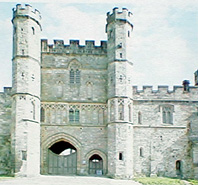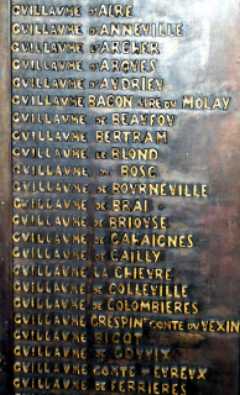|
The Companions of William Duke of Normandy, 1066.
 The Known List
The Known List The following persons are known to have been at the Battle of Hastings2: Those referred to by William of Potiers: The following are recorded as being in William's army and probably at Hastings: * Geoffrey de Mowbray, Bishop of Coutances.
[recorded by William of Potiers]
"A scroll tablet bearing the names of the counts, viscounts, barons and knights who fought at Hastings hung in the Abbey for generations..... was seen by early antiquaries, until it was removed to Cowdrey with the Conqueror's sword and other priceless relics...... destroyed in the fire which gutted Cowdrey in 1793. This roll of Battle Abbey has been denounced by dogmatic men like Lord Raglan, who held all but his own opinions in contempt. There is no doubt that monks were bribed much later to insert names of men not at Hastings but of lower origin whose families had become wealthy and powerful. But such insertions were discovered and do not number more than twenty". "On September 1066, some 5000 [more likely 8-9,000] men and their horses arrived by boat from Normandy. William, later to become known as 'the Conqueror', landed his men on the English coast at Pevensey. Hearing this, King Harold assembled a massive army to march to Hastings. However, his soldiers were exhausted, just having defeated the Norwegians in northern England. Before the English had regained their strength, the Normans attacked them seven miles northwest of Hastings."  "The Abbey of Battle was built by the Conqueror on
the site where by legend King Harold Godwinson leader of the English
fell and was a splendid building which the Conqueror. Battle Abbey
was enriched by William's successors. It contained the greatest treasures
of the Conquest, the sword of Conquero, the pallium sent by the
Pope and other relics of Hastings and was partly destroyed by
Henry VIII and given to his Master of Horse, whose son built a house
there, but the great gateway remains and is an impressive structure."
"The Abbey of Battle was built by the Conqueror on
the site where by legend King Harold Godwinson leader of the English
fell and was a splendid building which the Conqueror. Battle Abbey
was enriched by William's successors. It contained the greatest treasures
of the Conquest, the sword of Conquero, the pallium sent by the
Pope and other relics of Hastings and was partly destroyed by
Henry VIII and given to his Master of Horse, whose son built a house
there, but the great gateway remains and is an impressive structure."
For a Battle
Abbey Roll see Battle Abbey Roll Timekeeper The Falaise Roll The names of Les Compagnons de Guillaume ler Duc de Normandie a Hastings 1066. 
"There are about eight versions of the roll in addition to the version accepted by the French Government in 1931 which lists 315 men who were accepted and engraved on the bronze tablet erected in the Chapel of the Chateau [Castle] of William the Duke of Normandy at Falaise, Normandy. The Falase Roll is now housed in the Falaise Town Hall, downhill from the castle. The chief archaeologist at the castle is sceptical about the completeness of the Falaise Roll and suggests the wall mural over the main entrance to Dives Sur Mer Church may be more correct.8 There is also an alleged listing of William The Conqueror's retainers somewhere at Westminster.8
Links: William The Conqueror, Duke of Normandy - video
© Tim Midgley 2001, revised August 2023.
|









